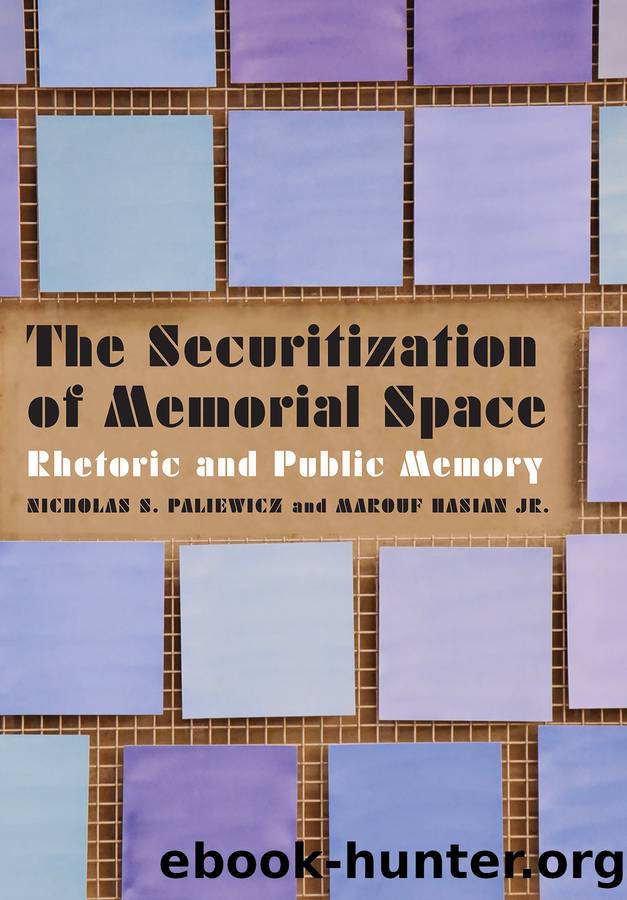The Securitization of Memorial Space by Nicholas S. Paliewicz & Marouf Hasian Jr

Author:Nicholas S. Paliewicz & Marouf Hasian, Jr. [Paliewicz, Nicholas S. & Hasian, Jr., Marouf]
Language: eng
Format: epub
Tags: POL002000 Political Science / Public Policy / City Planning & Urban Development, PHI034000 Philosophy / Social
Publisher: University of Nebraska Press
This assemblage, however, would not be the only one posing challenges for police and legal forces.
Many other environmental junctures and fissures were features of these complex assemblages. For example, technical arguments about urbanization and traffic flows around the National September 11 Memorial became topics in texts required by the National Environmental Policy Act for actions âsignificantly affecting the quality of the human environment.â34 The plaintiffsâ lawyers were interested in going after the police for failing âto explain and generally [suppressing] the N.Y.P.D.âs rationale for critical aspects of the plan based on a purported need for secrecy.â35
The arguments advanced in this case tested the NYPDâs rhetorical arguments that sustained the securitization of memorial space, especially in jurisprudential settings, because now they were having to discuss issues that, at first glance, may not have had anything to do with the usual constitutional or criminal rationales used by those with a great deal of discretion during times of emergency. Could the NYPD find a way of rationalizing the existence of that tightly knit security apparatus when they had to confront local citizens who could find creative ways of framing neighborhood needs?
Members of the WTC Neighborhood Alliance asserted that the NYPD overlooked the local effect of extensive security measures and failed to include public participation when crafting its security plan (see chapter 2). The plaintiffs could highlight the negative effects of closing off local streets to vehicular traffic, and requiring all vehicles to go through state-of-the-art security screening at the Vehicle Security Center, for instance, was detrimental to localsâ quality of life by congesting their neighborhoods with millions of tourists, polluting the air, and mitigating public space. In other words, the case was a fissure that challenged the absolute securitization of space. As the main petitioner, Ms. Perillo, put it in her affidavit: âI live in the City of New Yorkânot on campus or a gated community. I do not want to prove who I am to come home to my own apartment.â36
The specific arguments enumerated by the petitioners included a laundry list of items that the NYPD failed to take under consideration when they crafted their EIS. This catalog of proposed amendmentsâsent to the NYPD on March 12, 2012âincluded nineteen proposals for consideration, among them not-so-veiled argumentative critiques of police practices. For example, the list mentioned increased âpedestrian flow into and out of the WTC site and surrounding area to . . . prevent the creation of a âfortressâ environmentâ; a more transparent perimeter; âunobstructed access for residents, workers and visitors to and from the Memorial Plazaâ; diversion of pedestrian and vehicular congestion on local streets; the impacts of police, firefighters, emergency service personnel, parked vehicles, traffic, and security infrastructure around the WTC site, and other concerns.37
What the residents wanted, in sum, was less securitization of what was otherwise public and residential space. Because the NYPD implemented a federal EIS for the WTCâs security plan without âtaking a âhard lookâ at critical areas of environmental concernâ or adopting alternative proposals, the WTC Neighborhood
Download
This site does not store any files on its server. We only index and link to content provided by other sites. Please contact the content providers to delete copyright contents if any and email us, we'll remove relevant links or contents immediately.
Cecilia; Or, Memoirs of an Heiress — Volume 1 by Fanny Burney(31351)
Cecilia; Or, Memoirs of an Heiress — Volume 3 by Fanny Burney(30948)
Cecilia; Or, Memoirs of an Heiress — Volume 2 by Fanny Burney(30907)
The Great Music City by Andrea Baker(21571)
We're Going to Need More Wine by Gabrielle Union(18083)
Bombshells: Glamour Girls of a Lifetime by Sullivan Steve(13119)
Pimp by Iceberg Slim(12946)
All the Missing Girls by Megan Miranda(12774)
Fifty Shades Freed by E L James(12462)
Talking to Strangers by Malcolm Gladwell(11905)
Norse Mythology by Gaiman Neil(11901)
Crazy Rich Asians by Kevin Kwan(8369)
Mindhunter: Inside the FBI's Elite Serial Crime Unit by John E. Douglas & Mark Olshaker(7848)
The Lost Art of Listening by Michael P. Nichols(6481)
Enlightenment Now: The Case for Reason, Science, Humanism, and Progress by Steven Pinker(6414)
Bad Blood by John Carreyrou(5780)
The Four Agreements by Don Miguel Ruiz(5530)
Weapons of Math Destruction by Cathy O'Neil(5046)
We Need to Talk by Celeste Headlee(4879)
